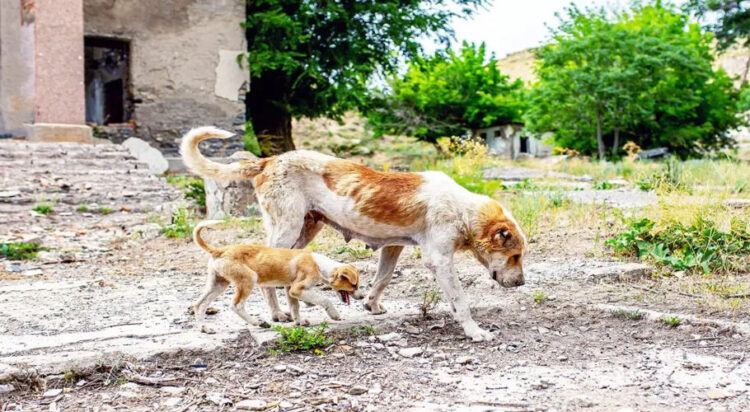In the radioactive wasteland surrounding the Chernobyl Nuclear Power Plant in Ukraine, a surprising phenomenon is unfolding. The dogs left behind after the 1986 nuclear disaster have not only survived but are thriving in an environment considered too dangerous for life. Now, these resilient creatures are at the center of groundbreaking scientific research that could reveal new insights into life’s ability to adapt to extreme conditions.
The Chernobyl Dogs: A Legacy of Survival:
When the Chernobyl disaster struck, many residents were forced to flee, abandoning their pets in the chaos. Among those left behind were hundreds of dogs that, against all odds, have managed to adapt to the harsh and radioactive conditions of the Exclusion Zone. Today, descendants of these dogs continue to roam the area, living in packs and scavenging for food left by the few workers who still visit.
Scientists have long been fascinated by the ability of these dogs to survive despite the high levels of radiation, toxic chemicals, and extreme weather. The dogs have formed tight-knit communities, some relying on human interaction for food and care, while others remain wary of people. But what makes these animals truly unique is how they have managed to endure in one of the most inhospitable places on Earth.
Unlocking Genetic Secrets:
A team of scientists, led by Dr. Norman J. Kleiman, has been studying the genetic makeup of these dogs to better understand how they’ve adapted to their harsh environment. Their research aims to answer a critical question: How does long-term exposure to radiation and environmental stress impact the genetic evolution of a population?
Through genetic testing, the researchers have found striking differences between two distinct groups of dogs living near the Chernobyl site. One group resides near the nuclear reactors, while the other lives about 10 miles away in the nearby town of Chernobyl. Despite their proximity, the two populations rarely interbreed, suggesting that their genetic paths have diverged over time due to the unique environmental pressures each group faces.
Dr. Kleiman’s team discovered 391 regions of the dogs’ genomes that appear to be significantly altered, possibly in response to radiation exposure. These genetic changes could provide valuable clues about how life forms adapt to environments with chronic environmental hazards.
Broader Implications for Humans:
The importance of this research extends far beyond the canine world. The dogs of Chernobyl are considered a “sentinel species” — animals that can provide early warnings about the health effects of environmental disasters. If scientists can pinpoint genetic changes in the dogs that are linked to their survival in such a toxic environment, it could offer insights into how humans and other species might cope with similar challenges.
“These findings could inform how we approach long-term health risks in populations exposed to radiation and toxic environments,” said Dr. Matthew Breen, a geneticist from NC State University. By studying how these dogs have survived in a radioactive wasteland, scientists hope to understand more about the broader genetic impacts of disasters like Chernobyl on both animal and human populations.
Still More to Learn:
While the initial findings are promising, the research is far from complete. Dr. Kleiman and his team caution that there’s still much to uncover about the long-term effects of radiation on the genetic health of these dogs. Ph.D. candidate Megan Dillion, who is leading the genetic analysis, is focused on understanding why there are such striking differences between the two dog populations and whether these differences are solely due to environmental stress or a combination of factors.
“We’re still in the early stages,” Dillion said. “The next step is to determine if these genetic markers are truly a result of radiation or just genetic drift over generations. This is a critical question we need to answer.”
Life in the Exclusion Zone: The Bigger Picture:
The Chernobyl Exclusion Zone remains a toxic and dangerous place, with lingering radiation, chemical pollutants, and unstable infrastructure. While the radiation levels have decreased since the 1986 meltdown, the area is still contaminated, and workers who regularly visit the site are at risk. The genetic research on Chernobyl’s dogs could shed light on how such an environment affects both the animals and the people who work in or near the area.
Dr. Kleiman emphasized that understanding the genetic responses of the dogs could ultimately help develop strategies to protect human health in similarly contaminated zones around the world. The study of these animals offers a rare opportunity to learn about survival and adaptation in one of the world’s most extreme environments.
The Resilience of Life:
In the end, the story of Chornobyl’s dogs is one of resilience and survival. These animals have lived for decades in one of the world’s most dangerous places, adapting to a life no human could endure. Their genetic legacy could hold the answers to some of science’s most pressing questions about survival, adaptation, and the impact of environmental disasters on living organisms.
As research into the Chernobyl dogs continues, scientists hope their findings will not only offer a deeper understanding of life’s adaptability but also provide insights that could help protect both humans and animals from the long-term effects of environmental disasters. Through these remarkable dogs, researchers are uncovering the hidden resilience of life, even in the harshest of conditions.



































